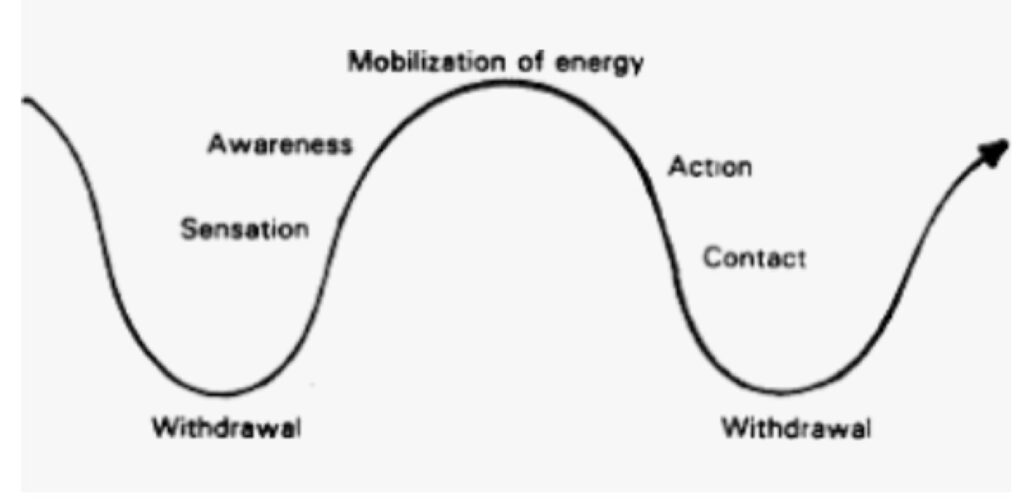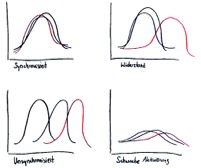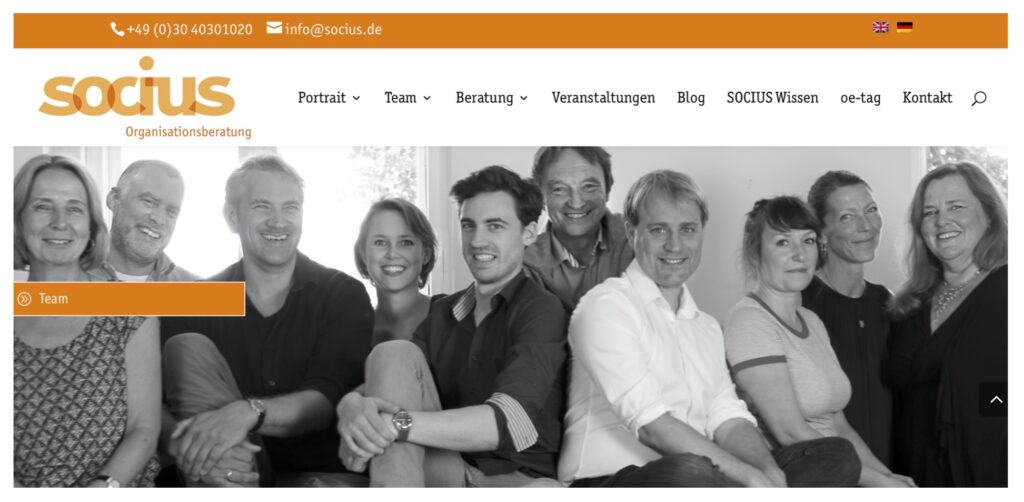The Gestalt Wave as a Map to Understanding „Groove“

The field of System Dynamics gives us a solid base and a fine language to conceptualise how systems operate and self-regulate in general. It is a framework and an integrated view on all levels of analysis – from the mico to the macro. What System Dynamics doesn’t do is provide insights on the specific functioning of human interaction, the patterns that emerge from the way we as humans are “wired”. To add to this understanding it may be helpful to take a look at the field of social psychology and therapy.

In the 1970s, Joseph Zinker and colleagues at the Gestalt Institute of Cleveland proposed an extended version of Fritz Perls’ “Cycle of Experience” – a wave model describing the process of self-regulation around the central Gestalt concept of “contact”. I will illustrate the six stages of this model with the classic analogy of eating an apple:
- Sensation: stimuli from the (internal or external) environment form an experience. For example: I have a strange uncomfortable feeling in my stomach.
- Awareness: the stimuli are pieced together to a meaningful whole (a “figure” or “Gestalt”[1]) from which a need surfaces. I recognize the sensation as hunger and I feel the desire to eat.
- Mobilisation of Energy: in a build-up of tension the need gets energized and fuelled towards action (at this moment the individual is in maximal disequilibrium). I heighten my senses and actively scan my environment for food.
- Action: the energy is focussed and used to move towards a solution. I reach out and grab the apple on the table in front of me.
- Contact: as the solution gets realised, a part of the environment is assimilated in a healthy “act of aggression”. I bite, chew and swallow the apple.
- Withdrawal: The need is satisfied and a state of equilibrium is reinstated. The apple is gone and my sensation of hunger vanes.
An interruption of the cycle (be it accidental or habitual) leads to “unfinished business” – a state that ties a lot of energy. Gestalt therapy has identified a number of ways the cycle of experience may be disturbed or interrupted: deflection (preventing sensing and awareness), introjection (swallowing without chewing), projection (interpreting the inside as outside), retroflection (pointing aggression inwards) as well as confluence (blurring the boundaries between inside and outside) are some of them. One of the key interventions of Gestalt therapy is to aid clients in their struggles with such disturbances in order to walk through the steps of the cycle with more ease, establish real contact and self-regulate to a state of equilibrium.
The model has not only been applied to individuals, also to the dynamics within families and groups (described here as the “Cycle of Interaction”). Edwin Nevis built on these ideas focusing on decision making processes in teams and organisations. In his foundational work “Organisational Consulting: A Gestalt Approach” he describes patterns and pathologies of collective cycles and proposes organisation development interventions to aid the fruitful application of all stages in the cycle.

Nevis describes several classic wave constellations in teams: Figure 1 shows the “ideal case” – a synchronised activation pattern: team members become aware of a need for action more or less simultaneously, mobilize energy and act in synch. Figure 2 shows an unsynchronised pattern: everyone gets excited and ready to act at a different time. Figure 3 (top right) shows a pattern of resistance (or less judgemental of “multi-directed energy”): One person’s timing counters the wave of the remaining group. Finally, figure 4 shows a weak activation pattern across the group, i.e. low energy leading to lacklustre action.
When I first came across Nevis’ charts, they made immediate sense to me. They give a clean visual representation and a fine framework of sense-making for what is and what should be going on in teams. Nevertheless, they can be misleading: Group dynamics are not merely the sum of individual dynamics and they are not easily captured in a static image. The systemic and iterative nature of interactions effects interferences of individual dynamics, creating complex patterns that may become characteristic for a group but are hardly predictable at the outset. If person A always activates first and “hogs the impulse stage”, B and C may fall into a pattern of resistance. A may get frustrated with this situation, so will B and C and finally the whole team ends up in a state of depression – a low activation pattern “because nothing good comes from bringing up new ideas here anyways”. The resulting constellations hold more information than visible at first sight.


Let’s go back to the ideal case – alignment. In most current definitions of self-organisation, team alignment relates to shared objectives and coordinated action plans. In the aligned state, rather than looking in all kinds of directions, the team is jointly oriented like iron shavings in a magnetic field. This “state of alignment” is important and has been proven to be a relevant factor of high team performance; however, it is nothing spectacularly new. Throughout the entire history of leadership and HR, people have been concerned with the question how to align individuals with collective or corporate goals. If everyone is aligned with the leader or the company (be it by incentives, pressure or inspiration), individuals in teams are consequently aligned with each other. Conceptually this vision is not very far from a totalitarian one. Everyone aligned under one cause, rallied to one flag, wearing the same uniform. What’s missing here is the idea of autonomy. How can alignment work if we honour everyone’s need and right to be themselves and bring their individual strengths and perspectives to the table? Spotify has coined the term “Aligened Autonomy” – in an animated explainer video that went viral in the interested scene, Spotify agility coach Henrik Kniberg challenges the idea of a continuum between alignment and autonomy to form a two axis diagram: low alignment and low autonomy signify a micro management culture. Alignment without autonomy means that leaders are communicating the cause and directing the solution. Low alignment paired with high autonomy in turn implies teams are free to do whatever they like. In the high alignment high autonomy situation leaders focus and frame the issues to be solved but let teams decide how they are going to deal with them.
In my eyes the most interesting part of alignment is a team’s ability to create alignment when there is neither a carrot, a stick or a charismatic leader around – the self-regulatory “process of alignment”. This ability to create alignment “from within” is a central ingredient of self-organisation. It is about timing, about fluid roles of leadership and followership and about finding a groove to move through the cycle of interaction in synch. Obviously, eating the cake is sort of the point while baking it is merely the means. But baking the cake is the actual art. High performance teams are not about eating a great cake but about baking it.
A Story of Alignment
2018 marked the 20th anniversary of our consultancy SOCIUS, a moment of looking up proudly surprised as an established player on the scene. The year also was to become the watershed of a long and cumbersome process of profound change in our team dynamics.
SOCIUS was founded by our most senior partner, Rudi, an entrepreneurial spirit with great drive and a magic sales pitch. Our growth throughout the years crept along organically: in the first decade, 4 of us joined, then another 4 in the 10 years to come. That is slow cooking! An exploration phase of setting up SOCIUS teams in three other cities was ceased after two years as communications went over our heads. We realized that we actually never aimed to get any bigger than a group sitting around a kitchen table for lunch – a ritual we practice quite consciously till today. We like it small and agile.
As a team we always modelled the dual core dilemma: We cherish the autonomy and freedom of each member and share the ideal of a partnership of equals – yet, there is a heroic atmosphere in our founding story and for a pretty long time we got along quite all right with a concentric power and leadership structure. With the pioneer as an enterprising figure, there was a centre of gravity, sometimes a source of inspiration to follow, sometimes a turbulence to collectively get irritated or annoyed with. It was the perfect double bind, most likely for both sides. Such a state can go on for long, but is not sustainable forever – as in most pioneering constellations, things needed to widen up. We were all clear that something more profound than merely switching co-director titles and talking about generation change had to happen. We needed a new self-concept and we had to discover how to bring our ideal of a self-organising collective to full life and practice. After a row of deep and strenuous soul-searching, Rudi took a step back. First, embarking on a months-long journey to the woods, after that, largely abstinent from the stage of internal development, he opened up space for the new emerging dynamic. Given that the co-management roles we had distributed were decidedly not about replacing the old heroic leadership model, the stage was somewhat empty.
In this moment, alignment was painfully missing. What was supposed to feel like a rebirth, a magic honeymoon, suddenly opened the view on our differences and on our insufficient experience to self-synchronise. Our resonance with each other was low. “Post heroic” seemed to imply “post focus”. Whenever someone came around with an idea or a development impulse, the reflex was to cautiously step on the break or to discover a counter impulse, effecting collective frustration and stagnation. Things felt wobbly and as the vacuum grew to become more painful, nostalgic thoughts about the good old times crept in – the hero never leaves the story.
It took us half a year and many struggling hours to find a groove. When we found it, it suddenly seemed like a new day. The consensus to establish and practice a model of self-organisation based on shared leadership and decentralised authority was established quite quickly. The tools and practices to make it happen keep us on our feet to this day, but we are on the way and we keep learning. All of us together.

In my eyes, the most crucial competence we acquired in this process as a team, is the ability to synchronize and create alignment in micro cycles of development. What constitutes this ability? And how – if at all – can it be trained and supported? Let’s revisit the Wave.
Training to Surf
I believe that every step of the “cycle of experience” commands a certain skill. Just like an individual, a group needs to be able to sense, become aware, mobilise, act, make contact and withdraw (and in turn can be disturbed in any stage of this process). These skills can be supported by practices or substituted by formal process. If the process prevails without an organic practice to fill it, the skill will atrophy like a muscle that is not used. We know this from so many settings: if money is offered to donate blood, the intrinsic motivation to donate is reduced, if you stay too long on your crutches, your muscles will be weakened and its had to walk without them; if a kid gets pampered, it doesn’t learn to stand on its own feet. We know it, yet it is hard to really act on it. We still rather want the structure than the process.
- Sensation: Sensing is physical. For a group to sense internal or external stimuli, it needs to shed some of its “knowing” and trade it for experiencing. Part of what makes a group attractive is the stability it offers. You are not on your own out there in the rain, but in the sheltered base of a collective. You know your team mates, you know what to expect from them, you know they know you. This comfort zone can become a trap, especially when the knowing is generalised to the group’s environment (“we know what to expect”). Sensations start with weak signals – if we want to catch them, we must short-wire our filters of perception and unlearn our knowing. We must open ourselves to experience. This is most of all an individual practice. An important aspect of this is where to look. Some teams are quite introvert and are mainly concerned with their internal dynamics. Others are very much outward oriented and sense a lot more in the environment than in their “intestines”. Whatever the case, it is important to be attentive to both aspects to distinguish what actually is an internal issue and what is external: is my vision blurred because there is fog out there or because my glasses fogged up? Extrovert teams tend to project internal issues to the environment. Introvert teams tend to take things personal that are actually just “out there”. To make a sensation collective, there needs to be open communication and contact. It is no use, if only one person has a sensation and doesn’t share it. Sharing a sensation that has not yet become a collective awareness is something quite tricky: is it real? Is it relevant? Does it fit in? if we want to encourage collective sensing, we need to establish a positive bias on these questions. Everything you sense is real. Everything you sense may be relevant. Everything fits in, because in the end: nothing actually really fits in. The formal practice to substitute sensing are routines of scanning internal and external environments. Formal scans, such as market research, benchmarking and strategic field analysis are helpful routines. If they become a “once a year we hire consultants to do this” kind of practice, they can become dangerous.
- Awareness: Group awareness forms within fields of resonance. For a team to collectively become aware, there needs to be a practice of sense making, a frame to interpret and assign common relevance and meaning to an issue. Whether or not this practice has a formal or informal frame doesn’t matter. Important is, that it is not something that you need to continuously organise. It has to become a second nature, something that happens routinely and with ease. If collective awareness is not on the menu for whatever reason, people that have an idea what a specific writing on the wall could mean need to step forward and propose a path of action. The words “need to step forward” are a soft imperative based on the realisation that groups depend on individual drive and courage to step up. Otherwise all we are is a flock of birds.
- Mobilisation of Energy: Collective mobilisation entails building commitment. Evidently, a managed decision to deploy resources and people to a cause has a different effect than people discovering they want to commit themselves. In a team alignment process this phase is characterized by situative leadership and emerging followership. Both of those roles require courage and need to be learned and practiced without becoming fixed roles. Followership is an underappreciated art. One of my favourite clips that I frequently show at leadership and OD trainings is “First Follower – Leadership Lessons from Dancing Guy”. In this 3 minute clip Derek Sievers dissects a scene at a festival … The questions asked from a sender perspective during the sensing stage (relevant, fitting in…), are of course equally valid to be asked from the receiver’s side: Is this impulse relevant and does it fit in? Or is it just a freak event, a disturbing whim that will pass? Again, the bias should be towards trusting, while at the same time not losing sight of what’s really relevant.
- Action: In the light of the Gestalt distinction between action and contact, collective action is not about implementation but rather about the decision for a course of action. Choosing the right response to a stimulus is not trivial. While the awareness of an issue and the readiness to act on it may be in alignment, the direction to move in often is not. This is where situative leadership and the ability to deal with conflicting impulses become relevant. Self-organisation is often illustrated by the image of a fish swarm or a flock of birds. The idea transported here is the absence of leadership: everyone is a follower at all times. Changes in direction are not attributed to a wilful or creative act of any individual but are purely reactive – a turbulence, an outside enemy, an obstacle in the environment cause a collectively intelligent reaction. This is a rather sad image of self-organisation. It neglects the possibility of a creative impulse and development drive of individuals that is embraced by the collective.
- Contact: If the collective wave has been smooth and in synch to this point, “doing it” can be a true flow experience. The act of implementation – writing the position paper, organising the clean-up event, hiring the new administrator – always effects a change of boundaries: take a bite and bring it in. Biting requires teeth. The reasons why in many organisations teams are quite good at making decisions but very bad at implementing them is that their mouths are already full. If you are chewing on your daily business, taking another bite to develop something new is not going to be very promising. The skill to learn here is to quickly shift focus from the daily activity portfolio to a development task and to get it done, be it in a forceful push, a carefully planned sprint or a disciplined ongoing practice. There is a lessons from martial arts here – a focus of breath that establishes a striking power way beyond the regular performance. This is all about practice.
- Withdrawal: Even in a VUCA world of continuous adaptation, a development move should have a signified end point. While withdrawal in the is not so much an active step but rather a state of resolution, this too requires a practice within the team: In order to share individual perspectives, a joint review of the cycle and its outcomes is helpful. Working groups should be thanked and disbanded. Successes, as well as disasters, should be celebrated. If the issue is resolved for everyone, the team can now go back to business as usual. If the Gestalt is left open (because implementation was stalled, the contact-phase did not happen in a satisfactorily manner or individual members are not on board with the outcome), energy will be drained from the team. To move out of a wave as a team is quite a vital part. The final picture can be the defining image that rests with us when remembering the cycle.
What comes after withdrawal? The Void. A blank canvas. It is this moment of Stillness that we need to learn to embrace. It this moment that is crucial for a new Gestalt to emerge.
[1] As Gestalt theory formulates it: “A figure emerges from the ground.” To understand the figure-ground concept, it is helpful to understand the Gestalt term: Gestalt is a meaningful whole, a figure that is complete but at the same time dynamic as it forms and vanes against the background of an experiential field.

